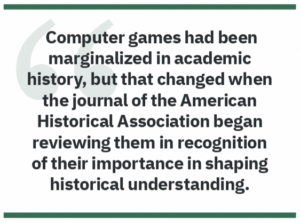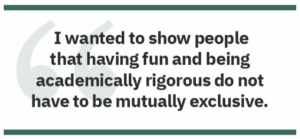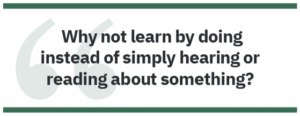By Paul Milliman
A well-designed educational experience can go beyond the traditional textbook and classroom format. By meeting gamer-historians where they are, the University of Arizona is building a new model of experiential learning.
When I was asked early last year whether I wanted to help build a program that would award college credit for playing the soon to be released Age of Empires IV, I jumped at the opportunity. Playing computer games is the first way many young (and not so young) people encounter medieval history, and I wanted to meet these gamer-historians where they were. That same semester I was teaching our senior capstone course, and one of the very best students in that course was someone I had never worked with before. Early in the semester I asked him how he had learned so much about medieval history, and he somewhat embarrassedly told me it was from doing research online while playing computer games, especially Age of Empires II. I wanted to help give talented students like this somewhere to go other than just Wikipedia. And so, the University of Arizona Enhanced Experience for Age of Empires IV began to take shape.
As far as I am aware, this is the first time a computer game production company (Microsoft’s World’s Edge) and an academic institution (the University of Arizona) have collaborated on a project to award college credit for playing a historical video game. Games, however, have played and continue to play an important role in many history courses. I teach courses about and with historical games, as does my partner in the Age of Empires endeavor, Dr. Alison Futrell, Head of the University of Arizona’s History Department and Associate Professor of Roman History.
Connecting Historical Facts with Modern Perceptions
 In our courses we also guide students in analyzing how representations of the past in popular culture help to shape our understanding of history. For the most part, computer games had been marginalized in academic history, but this changed last year when the American Historical Review — the journal of the American Historical Association — began reviewing computer games in recognition of their importance in shaping historical understanding. The inaugural reviews in this issue (March 2021) were accompanied by a wonderful article by Andrew Denning, who argues “Historians should understand how video games shape the wider public’s knowledge and philosophy of history, and they should develop strategies to bring the virtues of play into their own research and teaching.” A few months later, Ted Scheinman wrote an article for Smithsonian Magazine (October 2021) about the growing trend of history professors teaching with video games. Teaching with games had finally gone mainstream!
In our courses we also guide students in analyzing how representations of the past in popular culture help to shape our understanding of history. For the most part, computer games had been marginalized in academic history, but this changed last year when the American Historical Review — the journal of the American Historical Association — began reviewing computer games in recognition of their importance in shaping historical understanding. The inaugural reviews in this issue (March 2021) were accompanied by a wonderful article by Andrew Denning, who argues “Historians should understand how video games shape the wider public’s knowledge and philosophy of history, and they should develop strategies to bring the virtues of play into their own research and teaching.” A few months later, Ted Scheinman wrote an article for Smithsonian Magazine (October 2021) about the growing trend of history professors teaching with video games. Teaching with games had finally gone mainstream!
A Change in Teaching Methodology
The timing of the development of the University of Arizona Enhanced Experience for Age of Empires IV also coincided with a radical transformation in my own teaching philosophy and a redesign of my university’s General Education program to emphasize undergraduate research and experiential learning. When I first started teaching online more than a decade ago, my online courses looked exactly like my in-person courses: lectures, textbooks, essay exams, and term papers. I didn’t understand the freedom that comes with online instruction, and as an assistant professor, I was a little concerned about upending decades of tradition. It has been a slow process, but over the past decade I have created born-digital courses that look nothing like what I taught in the classroom in the 2000s.
The first things to go were the textbooks and readers. History textbooks are expensive and useless. They don’t teach you how to do history. They just perpetuate the myth that history is memorizing names and dates. As for the readers, why rely on sources someone else thinks are important? Because there are many good English translations of primary sources available for free online, or through my university’s library, I could tailor the primary sources to my courses rather than having to make my courses match primary-source readers.
The next things to go were the long lectures. Why are lectures so long? Because you have to fill 150 minutes of class time each week. How much learning is actually taking place? I personally can’t pay attention to someone talking at me for that long, so why should I expect my students to? I usually record a brief lecture for each module to introduce students to the primary sources they will analyze and the assignments they will do, but that’s it. I have become far more respectful of my student’s time since I began to look at the courses more from their point of view. How long would it take them to do this reading or assignment? I began putting this time in my instructions, which I continuously revise based on student feedback to make them as clear as possible.
Focusing on Learning Outcomes
Rather than filling class time, I began to think about how I could most meaningfully have my students use their time. The biggest change in how I thought about time came when I moved to teaching seven-week semesters. I had to completely revise my courses, and if I could not justify to a student why I asked them to do something, I excised it. The most important thing I excised from my courses were term papers and tests. Doing this allows me to focus more on undergraduate research and experiential learning.
I used to teach using two separate scaffolded tracks of assignments for students — the content track, which focused on preparing them for the midterm and final exams, and the research track, which prepared them to write the research paper. Some of the exams and essays were good, but most were not. A lot of the time I felt like a judge on “Nailed It!” Most of my students really tried their best, but very few of these students had the inclination or ability to be a professional historian in the way I am a professional historian. Were these really the best ways of assessing a student’s historical thinking skills? How could I nurture my students’ love of history by working with them to develop and refine historical thinking, researching, and writing skills in non-traditional and more engaging ways?
 I think that if I had not already been asking myself these questions, I would not have been prepared to help develop the Age of Empires IV program. There was no blueprint for anything like this, which was both liberating and daunting. Generally, historians are not very good collaborators, especially when it comes to course and curriculum design. There was a learning curve for me, but I firmly believe that the future of the academic discipline of history is in collaboration, especially in public-facing projects, so I wanted to help show what this future could look like.
I think that if I had not already been asking myself these questions, I would not have been prepared to help develop the Age of Empires IV program. There was no blueprint for anything like this, which was both liberating and daunting. Generally, historians are not very good collaborators, especially when it comes to course and curriculum design. There was a learning curve for me, but I firmly believe that the future of the academic discipline of history is in collaboration, especially in public-facing projects, so I wanted to help show what this future could look like.
Representing history through the game
Age of Empires IV presents different forms of history. First, there is the interactive narrative of fighting through various battles from England to China, covering nearly five centuries of history (1066-1552). There are Augmented Reality bridge videos between the battles which show how these past and present places are connected. And finally, there are “Hands-on-History” videos which are unlocked through your victory in a particular battle. These mini documentaries, shot on location throughout Europe and Asia, demonstrate how things were made and done in the past.
Professor Futrell and I wanted to build on this structure, so we created our own unlockable content for the game, called “Illuminated Histories.” These are Atlas Obscura style deep dives into the larger history surrounding the events the gamer-histories reenact in the game. We analyze medieval images and texts to help the gamer-historians understand more about the civilizations depicted in Age of Empires IV. We also model how to use open-access resources that the gamer-historians could use to do their own historical research, because our goal is not just to have them earn a college credit. We hope that credit will be the first in earning a degree from Arizona Online. In order to earn the credit, though, the gamer-historians first have to be assessed at the conclusion of all the campaigns.
Gamification as a University Recruitment Tool
I designed a gamified assessment — an online scavenger hunt in which the gamer-historians do guided research in the online collections of some of the world’s leading museums and libraries — both to determine whether they had completed the whole University of Arizona Enhanced Experience for Age of Empires IV and to measure their willingness to engage in historical thinking and research. They can take the assessment as many times as they want to, and once they pass it, they can apply to Arizona Online. If they are admitted, they earn the college credit. But this is just the beginning, we hope.
I have developed a special course just for the gamer-historians who enter Arizona Online through this program, Playing and Making History with Age of Empires IV. It is designed to be a bridge course that will enable gamer-historians to build on the skills they developed in the University of Arizona Enhanced Experience for Age of Empires IV. This is an active learning course designed to be a bit like a research and writing boot camp for historians, allowing them to apply the history they learned.
Gamer-historians learn how to:
- Use a variety of databases and other research tools to study history
- Summarize and critique scholars’ arguments
- Do original research and share it with their classmates through fun and engaging research projects based on playing and making pedagogies
They do just as much learning and research as in a traditional history course. But, instead of presenting their learning and research in tests and term papers, they present their research through experiential learning activities like cooking medieval recipes, creating medieval objects, or making their own games. They are not just consuming history — they are producing it, just like the Hands-on-History videos they watched in the game. They are doing their own hands-on history; in my opinion, experiential learning is the best way to learn history.
 Unlike math and foreign language courses, most history courses have no prerequisites, yet there’s an expectation of a certain level of content knowledge for participation. Too much time is spent on content acquisition because of a false assumption that without this, students cannot do research on this topic. Why not learn the content through doing research?
Unlike math and foreign language courses, most history courses have no prerequisites, yet there’s an expectation of a certain level of content knowledge for participation. Too much time is spent on content acquisition because of a false assumption that without this, students cannot do research on this topic. Why not learn the content through doing research?
An Inclusive and Engaging Learning Experience
All undergraduates can engage in guided historical research if the projects are well designed, the instructions are clearly written, and the teachers are willing to be a guide on the side rather than a sage on a stage. All history courses should be focused on research, not just the senior capstone. We just need to be more creative in how we engage students in research, and we need to be more transparent with our students and ourselves about our requirements and expectations. I hope the University of Arizona Enhanced Experience for Age of Empires IV demonstrates how historical thinking can be both meaningful and playful. Playful historical teaching and research can be far more engaging, exciting, and effective.
To learn more, visit https://bit.ly/AofEIV

PAUL MILLIMAN (milliman@arizona.edu) got his PhD in History from Cornell in 2007, the same year he started teaching at the University of Arizona. His research and teaching focus on games and food, and he tries to make his research as playful as his teaching. He just published an article analyzing an anecdote from a papal letter asking whether a Polish duke was seriously not going on crusade in the Mediterranean because he could not drink his native beer and mead there. He recently started archery and will soon take lessons on falconry and historical fencing to better understand medieval hands-on history.


